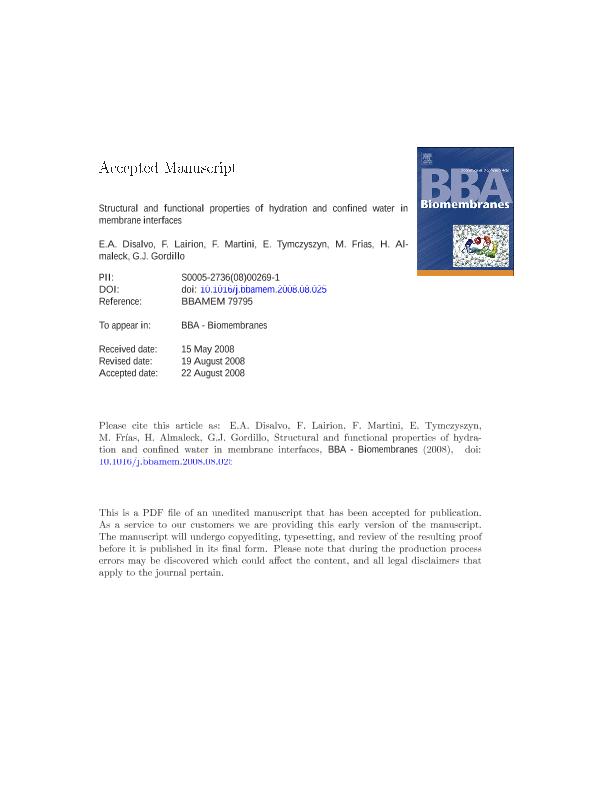Mostrar el registro sencillo del ítem
dc.contributor.author
Disalvo, Edgardo Anibal

dc.contributor.author
Lairion, Fabiana Norma

dc.contributor.author
Martini, María Florencia

dc.contributor.author
Tymczyszyn, Emma Elizabeth

dc.contributor.author
Frías, María de los Ángeles

dc.contributor.author
Almaleck, Samuel Hugo

dc.contributor.author
Gordillo, Gabriel Jorge

dc.date.available
2019-08-30T19:58:54Z
dc.date.issued
2008-12
dc.identifier.citation
Disalvo, Edgardo Anibal; Lairion, Fabiana Norma; Martini, María Florencia; Tymczyszyn, Emma Elizabeth; Frías, María de los Ángeles; et al.; Structural and functional properties of hydration and confined water in membrane interfaces; Elsevier Science; Biochimica et Biophysica Acta - Biomembranes; 1778; 12; 12-2008; 2655-2670
dc.identifier.issn
0005-2736
dc.identifier.uri
http://hdl.handle.net/11336/82664
dc.description.abstract
The scope of the present review focuses on the interfacial properties of cell membranes that may establish a link between the membrane and the cytosolic components. We present evidences that the current view of the membrane as a barrier of permeability that contains an aqueous solution of macromolecules may be replaced by one in which the membrane plays a structural and functional role. Although this idea has been previously suggested, the present is the first systematic work that puts into relevance the relation water-membrane in terms of thermodynamic and structural properties of the interphases that cannot be ignored in the understanding of cell function. To pursue this aim, we introduce a new definition of interphase, in which the water is organized in different levels on the surface with different binding energies. Altogether determines the surface free energy necessary for the structural response to changes in the surrounding media. The physical chemical properties of this region are interpreted in terms of hydration water and confined water, which explain the interaction with proteins and could affect the modulation of enzyme activity. Information provided by several methodologies indicates that the organization of the hydration states is not restricted to the membrane plane albeit to a region extending into the cytoplasm, in which polar head groups play a relevant role. In addition, dynamic properties studied by cyclic voltammetry allow one to deduce the energetics of the conformational changes of the lipid head group in relation to the head-head interactions due to the presence of carbonyls and phosphates at the interphase. These groups are, apparently, surrounded by more than one layer of water molecules: a tightly bound shell, that mostly contributes to the dipole potential, and a second one that may be displaced by proteins and osmotic stress. Hydration water around carbonyl and phosphate groups may change by the presence of polyhydroxylated compounds or by changing the chemical groups esterified to the phosphates, mainly choline, ethanolamine or glycerol. Thus, surface membrane properties, such as the dipole potential and the surface pressure, are modulated by the water at the interphase region by changing the structure of the membrane components. An understanding of the properties of the structural water located at the hydration sites and the functional water confined around the polar head groups modulated by the hydrocarbon chains is helpful to interpret and analyze the consequences of water loss at the membranes of dehydrated cells. In this regard, a correlation between the effects of water activity on cell growth and the lipid composition is discussed in terms of the recovery of the cell volume and their viability. Critical analyses of the properties of water at the interface of lipid membranes merging from these results and others from the literature suggest that the interface links the membrane with the aqueous soluble proteins in a functional unit in which the cell may be considered as a complex structure stabilized by water rather than a water solution of macromolecules surrounded by a semi permeable barrier.
dc.format
application/pdf
dc.language.iso
eng
dc.publisher
Elsevier Science

dc.rights
info:eu-repo/semantics/openAccess
dc.rights.uri
https://creativecommons.org/licenses/by-nc-nd/2.5/ar/
dc.subject
Carbonyl And Phosphate Groups
dc.subject
Confined Water
dc.subject
Dipole Potential
dc.subject
H-Bonding Compounds
dc.subject
Interphase Region
dc.subject
Lipid Membranes
dc.subject
Protein/Membrane Interaction
dc.subject
Surface Potential
dc.subject
Surface Pressure
dc.subject
Water of Hydration
dc.subject.classification
Alimentos y Bebidas

dc.subject.classification
Otras Ingenierías y Tecnologías

dc.subject.classification
INGENIERÍAS Y TECNOLOGÍAS

dc.title
Structural and functional properties of hydration and confined water in membrane interfaces
dc.type
info:eu-repo/semantics/article
dc.type
info:ar-repo/semantics/artículo
dc.type
info:eu-repo/semantics/publishedVersion
dc.date.updated
2019-03-27T18:03:52Z
dc.journal.volume
1778
dc.journal.number
12
dc.journal.pagination
2655-2670
dc.journal.pais
Países Bajos

dc.journal.ciudad
Amsterdam
dc.description.fil
Fil: Disalvo, Edgardo Anibal. Universidad de Buenos Aires. Facultad de Farmacia y Bioquímica. Departamento de Química Analítica y Fisicoquímica; Argentina. Consejo Nacional de Investigaciones Científicas y Técnicas; Argentina
dc.description.fil
Fil: Lairion, Fabiana Norma. Universidad de Buenos Aires. Facultad de Farmacia y Bioquímica. Departamento de Química Analítica y Fisicoquímica; Argentina. Consejo Nacional de Investigaciones Científicas y Técnicas; Argentina
dc.description.fil
Fil: Martini, María Florencia. Universidad de Buenos Aires. Facultad de Farmacia y Bioquímica. Departamento de Química Analítica y Fisicoquímica; Argentina. Consejo Nacional de Investigaciones Científicas y Técnicas; Argentina
dc.description.fil
Fil: Tymczyszyn, Emma Elizabeth. Universidad de Buenos Aires. Facultad de Farmacia y Bioquímica. Departamento de Química Analítica y Fisicoquímica; Argentina. Consejo Nacional de Investigaciones Científicas y Técnicas; Argentina
dc.description.fil
Fil: Frías, María de los Ángeles. Universidad de Buenos Aires. Facultad de Farmacia y Bioquímica. Departamento de Química Analítica y Fisicoquímica; Argentina. Consejo Nacional de Investigaciones Científicas y Técnicas; Argentina
dc.description.fil
Fil: Almaleck, Samuel Hugo. Universidad de Buenos Aires. Facultad de Farmacia y Bioquímica. Departamento de Química Analítica y Fisicoquímica; Argentina
dc.description.fil
Fil: Gordillo, Gabriel Jorge. Consejo Nacional de Investigaciones Científicas y Técnicas. Oficina de Coordinación Administrativa Ciudad Universitaria. Instituto de Química, Física de los Materiales, Medioambiente y Energía. Universidad de Buenos Aires. Facultad de Ciencias Exactas y Naturales. Instituto de Química, Física de los Materiales, Medioambiente y Energía; Argentina
dc.journal.title
Biochimica et Biophysica Acta - Biomembranes

dc.relation.alternativeid
info:eu-repo/semantics/altIdentifier/doi/http://dx.doi.org/10.1016/j.bbamem.2008.08.025
dc.relation.alternativeid
info:eu-repo/semantics/altIdentifier/url/https://www.sciencedirect.com/science/article/pii/S0005273608002691
Archivos asociados
